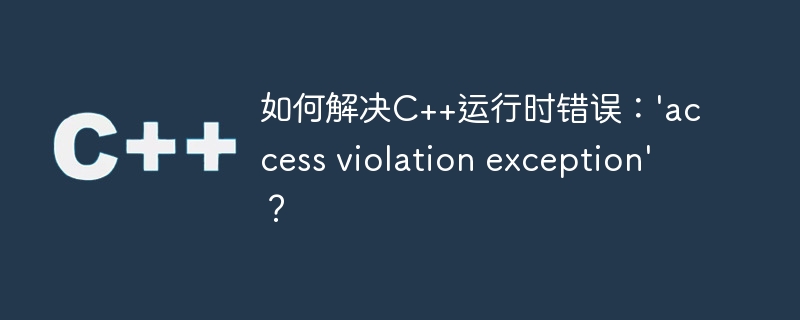

How to solve C runtime error: 'access violation exception'?
In C programming, we often encounter various runtime errors. One of the common errors is the "access violation exception". This error usually occurs when accessing a memory address that is not allocated to the current program, or when accessing a memory address that has been freed. The occurrence of this error often causes the program to crash or produce unpredictable results.
In order to solve this problem, we can take the following steps:
1. Check whether the pointer is NULL: In C, pointers are a very common cause of 'access violation exception' errors s reason. Before using a pointer, always make sure it is not NULL. If the pointer is NULL, it means that the pointer has no memory space allocated and therefore cannot access anything.
The following is a simple code example that demonstrates how to check whether the pointer is NULL:
int* ptr = nullptr;
if (ptr != nullptr) {
// 指针不为NULL,可以安全地访问
*ptr = 10;
}2. Reasonable use of new and delete operators: In C, we can use the new operator Allocate dynamic memory and release it using the delete operator. However, if we still access the memory after freeing it, it will result in an 'access violation exception' error. Therefore, it is very important to ensure that the freed memory is no longer accessed after it is freed.
The following is a sample code that shows how to use the new and delete operators correctly:
int* ptr = new int; // 使用ptr进行一些操作 delete ptr; // 确保在删除指针后不再访问它
3. Avoid array out-of-bounds access: Array out-of-bounds access is also a common cause of 'access violation exception' errors One of the reasons. In C, we must be careful to ensure that we do not access array elements beyond the bounds of the array.
The following is a code example that demonstrates how to avoid array out-of-bounds access:
int arr[5] = {1, 2, 3, 4, 5};
for (int i = 0; i <= 5; i++) {
// 避免访问arr[5]
cout << arr[i] << endl;
}4. Use exception handling mechanism: In C, we can use exception handling mechanism to handle runtime errors. When an 'access violation exception' error occurs, we can use the try-catch statement to catch and handle the exception.
The following is a simple code example that shows how to use the exception handling mechanism to handle the 'access violation exception' error:
try {
// 可能导致'access violation exception'的代码
} catch (const exception& e) {
// 异常处理代码
cerr << "发生'access violation exception'错误:" << e.what() << endl;
}Through the above steps, we can better understand and solve C runtime error: "access violation exception". Remember, when writing C programs, always check pointers carefully, use the new and delete operators wisely, avoid array out-of-bounds accesses, and use exception handling mechanisms to catch and handle these errors. This will help improve the stability and reliability of the program.
The above is the detailed content of How to solve C++ runtime error: 'access violation exception'?. For more information, please follow other related articles on the PHP Chinese website!
 What are the differences between c++ and c language
What are the differences between c++ and c language
 Recommended learning order for c++ and python
Recommended learning order for c++ and python
 Cost-effectiveness analysis of learning python and c++
Cost-effectiveness analysis of learning python and c++
 Is c language the same as c++?
Is c language the same as c++?
 Which is better to learn first, c language or c++?
Which is better to learn first, c language or c++?
 The difference and connection between c language and c++
The difference and connection between c language and c++
 C++ software Chinese change tutorial
C++ software Chinese change tutorial
 Cost-effectiveness analysis of learning python, java and c++
Cost-effectiveness analysis of learning python, java and c++




